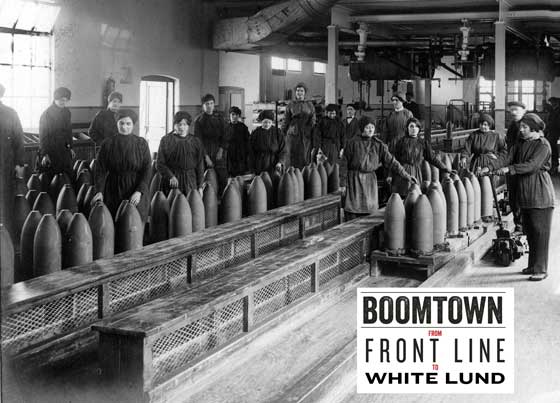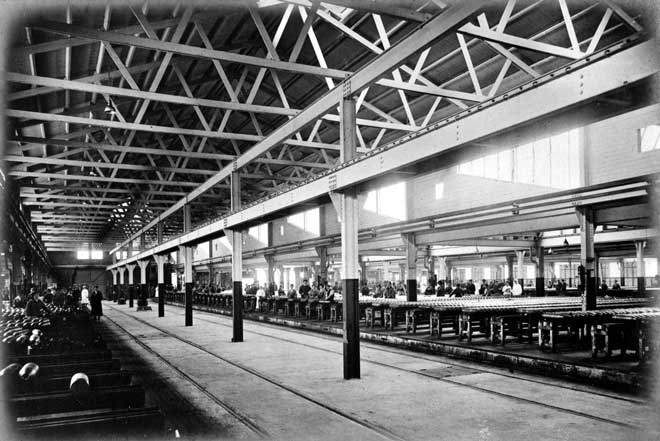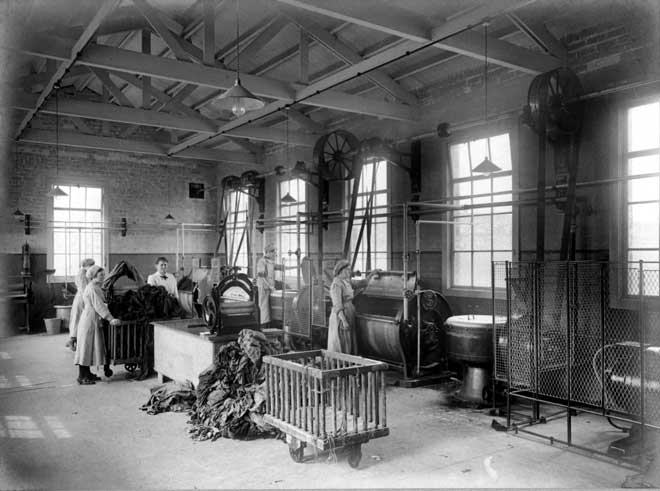The Great War Centenary
1917 - ExhibitionBoomtown - From
Front Line to White Lund
What happened in National Filling Factory No. 13?

White Lund NFF No 13 took in bulk quantities of explosives especially
TNT (trinitrotoluene) and Ammonium Nitrate. These raw materials were
kept separate and secure until they were ready for processing.
Small quantities of explosives were worked on at any one time to reduce
the risk of major destruction. First the Ammonium Nitrate was broken up
and put through a rotary dryer to reach a precise moisture content. It
was taken to Incorporating Houses along with measured quantities of TNT.
When fully mixed Amatol was formed. Different percentage mixes were used
for different shells.
The Amatol was used to fill empty shell cases manufactured in National
Projectile Factories – including that on Caton Road in Lancaster. Shell
cases were checked, cleaned and painted before being delivered to the
Filling House.
In some combinations the Amatol was melted, in others it was used in
powder form. After filling, the shells were passed to the next unit to
be fitted with the exploder and nose plug.
Once completed they had to be safely and swiftly moved from the Filling
Houses to the Transit House for weighing, marking (painting) and dating
before being moved to the Bonded Stores to await shipping.
The factory filled varying sizes of shells with High Explosives.
Originally there were four units for 9.2 inch shells and 1 unit each for
6 inch and 60-pound shells. They are also known to have filled 8 inch
and 12 inch shells.
For efficient and safe movement around the site some 12 miles of railway
tracks covered the site, operated by fireless locomotives, which took a
charge of steam from the boiler house, so there was no risks of sparks.
Series of photographs showing the various processes in the
factory:

Drying the constituents of high explosives
One of the first operations in preparing high explosives for filling the
shells is the drying of the constituent elements. This is done in a
rotary machine, which very slowly passes the material against a hot-air
blast. This view shows the room in which the drying process is carried
out.

Milling of high explosives
Having been treated, the ingredients for the high explosives are brought
together by mixing under pressure in mills similar to those used for the
manufacture of mortar; the view opposite shows this procedure. Following
upon this, the material is taken to a machine with corrugated rollers,
to reduce it to a homogeneous powder ready for passing into the shell.

Shells arrive ready to be filled
From National Projectile Factories and other workshops across the
country empty shells arrive to be filled with high explosives.

Filling the shell with high explosives
Shells are first filled by hand, with the use of a boxwood rammer.

Filling the shell with high explosives
The contents are then compacted under hydraulic pressure.

Filling shells with melted explosives
An alternative system of filling shells is adopted, and the building in
which this is done is illustrated here. In this case the explosives are
introduced in a liquid form, being allowed to cool and solidify within
the shell. The last operation in the filling process, whether dry or
liquefied explosives are used, is the fitting of an exploder and the
sealing and plugging of the shell, ready for the reception of the fuse.

Painting the shells
Each shell is painted and marked with various details before being
despatched to the Front Line.

The laundry for the workers' uniforms
Every provision is made to guard against accident and fire. Not
only are the buildings isolated, but the workers and apparatus for
carrying out some of the processes are separated by cubicles. In
all cases, too, the workers are supplied with overalls which are
fire-resisting. These overalls are frequently washed, and after
being dried are steeped in a fire resisting solution. This is a
view of the laundry and through it passes twice weekly 3000 overalls.
© Images are copyright, Trustees of the King's Own Royal Regiment Museum.
You must seek permission prior to
publication of any of our images.
Only a proportion of our collections
are on display at anyone time. Certain items are on loan for display
in other institutions. An appointment is required to consult any of
our collections which are held in store.










